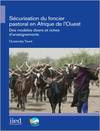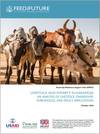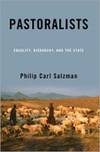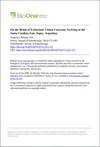Combien de temps peut durer une transhumance ? Qui part et avec quels animaux ? Les éleveurs mobiles contribuent-ils à l’économie locale des régions où ils se rendent ? De quelles façons s’informent-ils ? Traversent-ils tous des frontières internationales ? Vendent-ils du bétail ? Cette brochure résume les principales conclusions d’une étude menée par Acting for Life auprès de familles transhumantes, suivies de 2014 à 2017 dans le cadre du Programme BRACED.
Year of publication: 2018Organization: مركز التعاون الدولى للبحوث الزراعية من أجل التنمية
Topic: تغير المناخ, صراع, اقتصاد, أمن غذائي, الرعاية الصحية, الإدراك الفطري, نوع الملكية, مرونة, خدمات اجتماعية, القيمة المضافة
Language: Français
Type of document: تقني
Geographical coverage: غربية افريقيا, أفريقيا الوسطى
En Afrique de l'Ouest, les systèmes agricoles et pastoraux ont connu d'importantes reconfigurations depuis le début des années 2000.Cela a conduit à une concurrence autour de l'accès à l'espace terrestre, renforcée par la ruée des multinationales vers les ressources naturelles disponibles dans les zones pastorales de la zone sahélienne, ainsi que par l'extension des grands centres urbains.Pour relever ces défis, des expériences de sécurisation des espaces pastoraux sont actuellement menées sur le terrain au Burkina Faso (régions du Sahel et de l'Est), au Niger (région de Maradi et département de Niamey) et au Sénégal (département de Podor). Cette étude combine une revue documentaire, mène des entretiens avec les différents acteurs impliqués et mène des enquêtes auprès des éleveurs.L'objectif est d'établir une évaluation critique de ces expériences de sécurité pastorale, d'évaluer leur efficacité et d'analyser la stratégie d'implication des organisations d'éleveurs.Le financement de ces différents modèles de sécurité foncière fournira des leçons utiles pour un changement d'échelle dans la conduite de telles expériences et le renforcement des stratégies visant à prévenir les conflits liés à l'accès.
Year of publication: 2018Organization: المعهد الدولى للبيئة والتنمية
Topic: نوع الملكية
Language: Français
Type of document: تقني
Geographical coverage: غربية افريقيا
Pastoralism is the main livelihood of an estimated 268 million people in Africa’s drylands. It represents one of the most viable – and sometimes the only suitable – livelihood options for the drylands. Pastoralist populations are increasingly vulnerable to malnutrition and food insecurity. Their capacity to adapt to and recover from crises declines in the face of recurrent and often overlapping shocks. This paper presents efforts to reducing risks, addressing vulnerability and enhancing resilience of pastoralist communities. Pastoralist communities are key actors and an integral part of a lasting solution to ensure the stability of Africa’s drylands.
Year of publication: 2018Organization: منظمة الأغذية والزراعة للأمم المتحدة
Topic: تغير المناخ, صراع, اقتصاد, الخدمات البيئية, أمن غذائي, نوع الملكية, مرونة, خدمات اجتماعية
Language: English
Type of document: تقني
Geographical coverage: شمال أفريقيا, غربية افريقيا, أفريقيا الوسطى, شرق أفريقيا, جنوب أفريقيا
This report analyses poverty in Karamoja from the perspective of livestock ownership, and uses a livestock threshold to categorize households as poor and non-poor. High levels of livestock poverty are then discussed in relation to programming and policy options. The analysis uses raw data from a recent livestock population survey to analyze livestock ownership in Karamoja. The survey did not collect information on the ownership of camels, donkeys or poultry, and so overall, the livestock ownership results in the analysis are an under-estimate of actual ownership. It covered the six main livestock-rearing districts of Karamoja viz. Napak, Nakapiripirit, Moroto, Kaabong, Kotido, and Amudat.
Year of publication: 2018Organization: كتاب مستقلون
Topic: اقتصاد
Language: English
Type of document: تقني
Geographical coverage: شرق أفريقيا
Drawing upon the author's extensive field research among pastoral peoples in the Middle East, India, and the Mediterranean, and on more than 30 years of comparative study of pastoralists around the world, Pastoralists is an authoritative synthesis of the varieties of pastoral life. At an ethnographic level, the concise volume provides detailed analyses of divergent types of pastoral societies, including segmentary tribes, tribal chiefdoms, and peasant pastoralists. At the same time, it addresses a set of substantive theoretical issues: ecological and cultural variation, equality and inequality, hierarchy and the basis of power, and state power and resistance. The book validates "pastoralists" as a conceptual category even as it reveals the diversity of societies, subsistence strategies, and power arrangements subsumed by that term.
Year of publication: 2018Organization: كتاب مستقلون
Topic: اقتصاد, منظمة
Language: English
Type of document: تقني
Geographical coverage: مناطق العالم
This paper presents a systematic study of the factors relating to the decline in the use of caravans in northwestern Argentina based on data collected from 2013 to 2017. Three reasons are offered (two socioeconomic and one environmental) to explain the observed decline: (a) the presence of a growing textile industry in Bolivia, with an increase in the demand for camelid fiber; (b) the improvement in living conditions in Bolivia; and (c) the drought that affected the area, with very little pasture for the animals on their route.
Year of publication: 2018Organization: كتاب مستقلون
Topic: الخدمات البيئية, مشاركة
Language: English
Type of document: علمي
Geographical coverage: أمريكا اللاتينية
Camilla Toulmin, of the International Institute for Environment and Development (IIED), explains why uncertainty is a useful lens for looking at pastoralism, and how the PASTRES project could contribute to the debate about pastoral development.
Year of publication: 2018Organization: المعهد الدولى للبيئة والتنمية
Topic: تغير المناخ, مرونة
Language: English
Type of document: فيديو
Geographical coverage: مناطق العالم
This manual shows how pastoralists and other livestock-keeping communities can draw up a community protocol about their animal breed or production system. It describes why they should consider producing a community protocol, walks through the steps of doing so, and advices how to use the finished document. It explains in easy language the complex concepts of access and benefit sharing and how the community protocol can be used within the legal system. This manual is aimed at community leaders and organizations, nongovernment organizations and all those concerned with managing and conserving animal breeds and production systems.
Year of publication: 2018Organization: ,
Topic: الخدمات البيئية, الإدراك الفطري, منظمة
Language: English
Type of document: تقني
Geographical coverage: مناطق العالم









